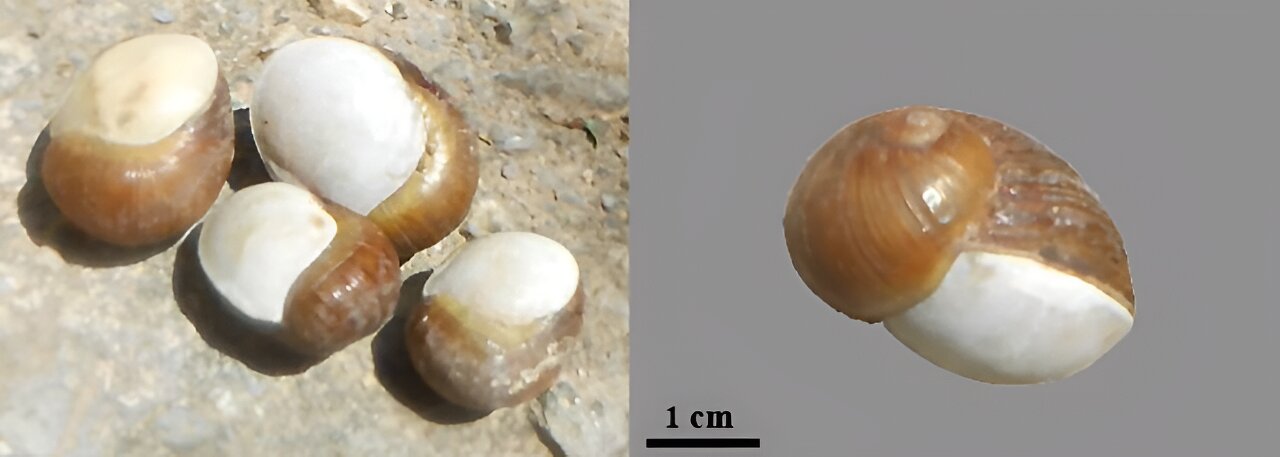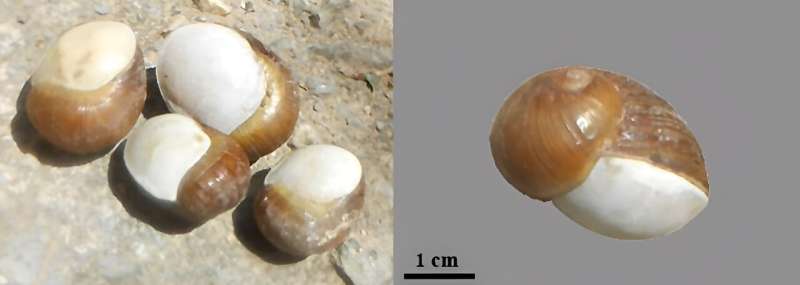

A new study by Dr. Ismail Saafi from the Aix-Marseille Université provides details on the discovery of cooked snail remains at Kef Ezzahi in northern Tunisia. The snail remains, dating back approximately 7710 years, are the only known cases of snail remains in northern Africa with their epiphragms (temporary closing membrane) intact.
The findings raise questions and shed light on snail consumption and the antiquity of culinary traditions in Tunisian societies. The findings are published in the journal Archaeological and Anthropological Sciences.
The site of Kef Ezzahi is one of a handful of sites that contain a rammadiyet (massive accumulations of shell remains). During excavations conducted at the site in 2012, shells belonging to the species Sphincterochila candidissima were uncovered. Of these over 35,000 remains, 41 revealed the presence of epiphragms.
Dr. Saafi explains the function of this epiphragm, “Land snails produce an epiphragm when climatic conditions are unfavorable for their activity (temperature varies between 5° and 25°, presence of rain or high humidity). The epiphragm protects against water loss, especially when the temperature rises.”
The finding is remarkable because it is the only known case in northern Africa and may be one of the oldest pieces of evidence pointing to humans consuming snails with epiphragms.
“In Turkey, Pomatias elegans shells with an epiphragm were discovered at the Üçağizli Cave I site (41000–29000 uncalibrated BP). The presence of a perforation in the middle of the epiphragm of a shell encourages researchers to consider consumption of the flesh by a predator. So, this is not a collection for consumption,” says Dr. Saafi.
“So far, the discovery at Kef Ezzahi is the oldest evidence of the collection of land snails with epiphragm in relation to consumption.”
In order to understand why snails with epiphragms may be so rare in archaeology, Dr. Saafi conducted an ethnographic study of a modern population living in Aouled Said.
The inhabitants of Aouled Said (or Saâïd) collect Cantareus apertus, a snail that also produces epiphragms. His study found that individual families and groups in Tunisia will collect only certain species of snail, which is usually based on their size and taste.
The group living in Aouled Said set out to collect Cantareus apertus snails, which can only be found in Tunisia’s north. In summer, these snails enter a period of estivation (a period of rest similar to hibernation). During this time, they burrow underground and create an epiphragm.
Collectors of the snail need to harvest the snail in summer, between April and July. To do this, collectors use pickaxes to dig into the ground. Once collected, the snails need to be placed into a container of ash or sawdust, or else the snail will shed its epiphragm.
Any snails that shed their epiphragm or do not have one are thrown away or avoided as they are viewed as dirty. It is imperative to collect the snails at the correct time; if they are left in their resting phase for too long, they become bitter, and their mass reduces, making them less favorable on the market or for consumption.
On average, collectors are able to collect about 1kg of snails in a single day, leaving behind the juveniles to ensure the species’ survival and abundance for the next season. Due to the amount of physically strenuous activity required to gather these snails, it is usually a task relegated to men or young people over the age of 15. The skill and know-how of this collection technique is passed down from one generation to the next.
The lack of epiphragms in other archaeological contexts is unlikely to be a preservation bias. This is because while easy to remove, once in the archaeological deposit, epiphragms remain relatively unchanged.
According to Dr. Saafi, “An epiphragm can be best preserved when it is still stuck to the entrance of the shell. Once the shell has been buried in the archaeological deposit (mainly ash in the case of our study sites), the changes are less significant [except in the case of contact with another, harder archaeological object (flint or stone)].”
Instead, their rarity in archaeology is likely linked to how difficult they are to obtain. As seen in the ethnographic study, one requires a unique set of skills in order to know where to look for snails with epiphragms and when to collect them. On top of this, the physical effort required and the limited season of collection may make them less desirable as collection targets as compared to other snails, which may be more widespread and can be collected year-round in larger quantities.
Dr. Saafi elaborates, saying, “This rarity could be due to a culinary tradition that was not popular with ancient populations. To eat the shells, the epiphragm must be removed to extract the body of the mollusk from its shell. So, this rarity is linked more to culinary practices (collection and consumption) than to a conservation bias.”
It is possible that a group of prehistoric Tunisians practiced the collection of S. candidissima, similar to how modern groups in Tunisia specialize in the collection of one type of snail species. Passing this technique down through the generations, as evidenced by the fact that S. candidissima snails, which made up 90% of the snail species at Kef Ezzahi, are found through the deposit, suggesting its continued collection through time.
However, due to the limitations of collecting this species, other groups and sites with shell remains did not adopt the collection of S. candidissima or other epiphragm-producing snails, hence why they are so rare in archaeology.
“This discovery confirms the antiquity and continuity of certain practices linked to culinary and cultural traditions in the exploitation of land snails, such as the extraction of the mollusk bodies after the shell has been pierced. These data give us a better understanding of the status of land snails among ancient and contemporary populations,” says Dr. Saafi.
More information:
Ismail Saafi, Shells with epiphragms in an Upper Capsian rammadiya at Kef Ezzahi (Central Tunisia): a local food tradition?, Archaeological and Anthropological Sciences (2024). DOI: 10.1007/s12520-024-02071-9
© 2024 Science X Network
Citation:
Tunisian snail remains provide insights on a possible 7700-year-old local food tradition (2024, October 8)
retrieved 8 October 2024
from https://phys.org/news/2024-10-tunisian-snail-insights-year-local.html
This document is subject to copyright. Apart from any fair dealing for the purpose of private study or research, no
part may be reproduced without the written permission. The content is provided for information purposes only.